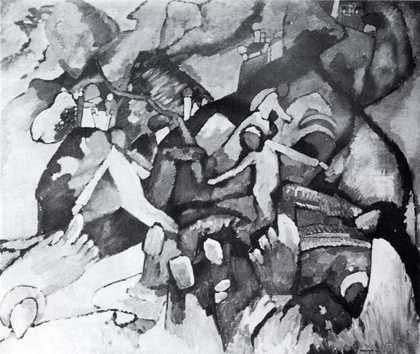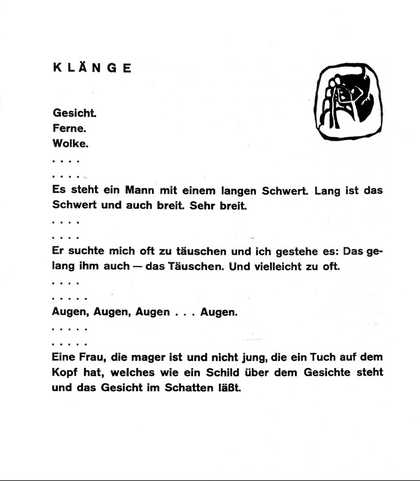
Fig.1
Wassily Kandinsky
'Klänge' from the album Klänge, Piper & Co., Munich c.1912
British Library © DACS, London
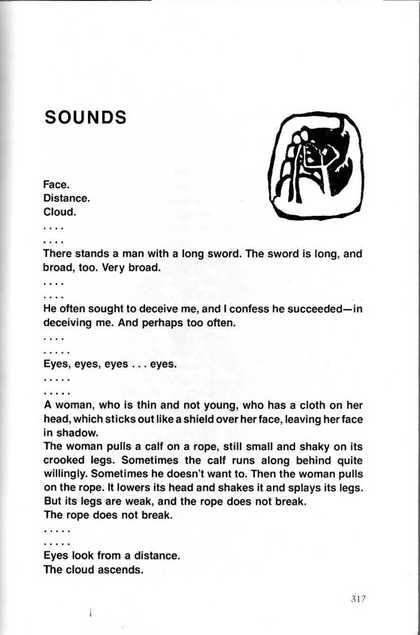
Fig.1a
Wassily Kandinsky
'Klänge' from the album Klänge, Piper & Co., Munich c.1912
English translation
British Library © DACS, London
In 1938 Wassily Kandinsky published the text ‘My Woodcuts’ in the French periodical XXe Siècle. As was so often the case, when he wrote about his prints he focused largely on general artistic principles: the majority of the text is devoted to a general discussion of the need to privilege ‘synthesis’ over ‘analysis’ in both art and in life. However, he specifically referred to the album of poetry and engravings Sounds (Klänge), which had been published in Munich c.1912, as ‘a small example of synthetic work’,1 and it is this aspect of the album that is the subject of this article.
Kandinsky’s understanding of synthesis had been established in pre-war texts, the most important of which was On the Spiritual in Art, published in 1911. There he describes how each of the arts attends to its own materials, ‘weighing on a spiritual balance the inner worth of those elements out of which their art is best suited to create’.2 He writes that this distinguishes each art from the others, but that it simultaneously draws them together in terms of their ‘inner strivings.’ This leads to the possibility of synthesis: ‘And so, finally, one will arrive at a combination of the particular forces belonging to different arts. Out of this combination will arise in time a new art, an art we can foresee even today, a truly monumental art.3
Attention has been drawn to diverse precedents for this idea of synthesis. His enthusiasm for the concept of a ‘total work of art’ was fired by a combination of these sources, many of which were rooted in romantic theory, and that of Richard Wagner in particular. However, Kandinsky went beyond what he later came to see as the simple reinforcement of one art form by another, such as he thought Wagner had proposed. As early as 1910, in the essay ‘Content and Form’, Kandinsky suggested the possibility of a more complex relationship between the arts. In monumental art, he wrote, each art becomes the ‘joint begetter of the work’; within the work, ‘each art is brought to the fore or relegated to the background, according to the principle of direct or inverted contrast’.4 The 1911 additions to the original (1909) typescript of On the Spiritual in Art5 demonstrate a stronger assertion of this principle: monumental art should be created by means of ‘juxtaposition (= opposition)’,6 through the emancipation of each individual element.7 As I have shown elsewhere, he would continue to develop these ideas in part in response to the writings of the composer Arnold Schoenberg.8
Consistent throughout his writings is the notion of ‘inner necessity’, a spiritual, somewhat romantic, demand that the artist express an ‘inner experience’ that emanated from the soul. In his essay ‘On the Question of Form’ published in the almanach The Blue Rider in 1912, he writes that the artist may use any forms ‘in order to express his inner emotions and experiences … exercising his right to make use of any form that is internally necessary for him.’9 The painter can thus use realist or abstract form, or whatever medium is necessary in order to articulate his inner world. This principle led Kandinsky himself to engage with different media through his career, sometimes combining several in one work. Given the range of art forms which could be brought to bear in a stage piece such as The Yellow Sound, the script for which was included in The Blue Rider, we might be right to conclude that this is the sort of work Kandinsky had in mind when writing of the monumental art. However, it is also evident that Kandinsky thought of other projects as based upon the same principle, and the art historian Peter Vergo has described The Blue Rider itself as ‘a ‘synthetic’ publication aimed at forging a link between different art forms … Poets, musicians, painters and critics all contributed.’10
Sounds
Sounds comprised thirty-eight prose poems which were accompanied by twelve colour and forty-four black and white woodcuts, each hand-printed under Kandinsky’s supervision. It was published in an edition of 345 c.1912 (it was scheduled to be published in autumn of that year but the exact date of its appearance remains uncertain). The page shown in fig.1 contains a title (‘Klänge’, the same as the title of the album), most of the poem (which continues onto the next page) and a woodcut.
The poems contained in the album were written between 1909 and 1911. They draw attention to and manipulate the sounds of words in such a way as to destabilise their conventional meanings. ‘Words’, Kandinsky wrote in On the Spiritual in Art, ‘are inner sounds … Skilful use of a word (according to poetic feeling) – an internally necessary repetition of a word twice, three times – can lead [to] unrealised spiritual qualities of the word. Eventually, manifold repetition … makes it lose its external sense as a name’.11 With this quest for ‘inner meaning’, ‘great possibilities open up for the literature of the future’ as language breaks from the constraints of its traditional usage.
As we read the poems, acoustic rhythms couple with spatial ones to halt our progress through them: we find ourselves re-reading, our eyes moving around the poems, attempting to re-engage or re-enter the works. The sound of the words and the unconventional spacing of words across the page, as well as the remnants of narrative, both ‘articulate’ and ‘dis-articulate’ the whole. The process of re-reading and moving visually around the poem seems to make the text more open: syntax and narrative are lost; the spaces between and beyond words, lines and stanzas, appear to threaten the unity of the text; and – according to Kandinsky’s claims – the words may evoke psychological, synaesthetic or even spiritual associations beyond their literal meanings.
Four of the woodcuts in Sounds were produced in 1907, forty-seven in 1911 and the remaining five in 1912. Over this period they became increasingly abstract, though careful attention allows us to recognise, in most, references to the corporeal world. Nonetheless, what has just been said of the poems applies equally to the prints: narrative and conventional meaning is largely lost as abstracted form dominates. Again, we are denied access to the work on familiar terms, and we are forced, once more, to move into and out from the forms and spaces between them in search of meaning.
Through this process of engagement and refusal of our attention, both text and print repeatedly attract and repel the viewer. We move from exploration of one to exploration of the other. In this way, the prints begin to enter the space of the texts as the texts begin to enter the space of the prints. The common white ground upon which both text and print stand, as figure, is the medium which articulates these intrusions.
In this, Kandinsky aimed to overcome the relationship between text and image where one serves as explanation, or illustration, of the other. In his art theory, Kandinsky offered clues as to how he intended the interrelations between these quite separate, yet now mutually implicated, art forms to be understood.
In the 1912 essay ‘On the Question of Form’, Kandinsky pays particular attention to the function of a letter and of a dash. The text offers a dash, ‘used in the right place – as here – …’12 identifying it as practical and purposive. He then suggests we lengthen the line while leaving it in the same place. The sense of the line remains, he tells us, as does its significance; yet, the line now takes on an ‘indefinable coloration’ that called the line’s function as a hyphen into question.13 In the wrong place, ‘(as in this – instance)’, this uncertainty increases. ‘As long as this or that line remains in a book, the practical or purposeful element cannot be definitely excluded.’14 The move to a canvas, he suggests, begins to resolve this uncertainty as the line may become ‘pure’, but as long as the line remains in a book, the practical-purposive element cannot be fully excluded.
In the section titled ‘On Point’ in ‘Little Articles on Big Questions’ (1919), Kandinsky develops this analysis further. The text attends first to punctuation. Again, Kandinsky describes the overturning of the conventional function of punctuation and the emancipation of its ‘inner sound’. ‘At this juncture I put a . A whole world now vacillates’. The point, he writes, is in the wrong place and external expedience suffers; it is perceived as a misprint or accident. The ‘veil’ of expediency that hides inner meaning is challenged and the ‘secret meaning’ can be discerned. He continues:
I refute the practical meaning of the point and put one here:
•
It becomes ‘nonsensical’, he writes, as it breaks the conventions of its existence. Kandinsky writes that the reader ‘has suddenly been transformed into a spectator [my emphasis]’, as the point appears in a clean part of the page. ‘He says farewell to the now insane punctuation mark and sees before him a graphic and painterly sign.’15 ‘I summon my reader to enter a new world, one that is called now a temple, now a studio, and one whose eternal name is art.’
Next, in the passage ‘On Line’ in the same essay, he describes:
First, the short stroke, the tie, or the hyphen -
Second, the long stroke, the dash —-
Once the reader, transformed into a spectator, moves from practical meaning, so
On a clean sheet of paper suddenly obtains a second graphic sign, a second graphic entity ————————– line.
From these two elements, point and line, Kandinsky writes, we derive the entire resources of a whole realm of art – graphics. But Kandinsky does not situate his line on a clean sheet as he suggests and, in his ‘illustration’, maintains the line’s function as a hyphen – it leads from the sentence’s description to the naming of its object. It is a graphic element within the text itself and thus, as identified in ‘On the Question of Form’, remains ‘within a book’ and therefore ambiguous. Kandinsky begins to enjoy this ambiguity.
In Point and Line to Plane of 1926 Kandinsky develops these accounts. In the first chapter, entitled ‘Point’, he once again cites an instance of the point becoming emancipated from convention:
The point is transferred from its practical, purposive state into one that is nonpurposive, i.e., alogical.
Today I am going to the cinema.
Today I am going. To the cinema
Today I. Am going to the cinema
He writes that in the second and third cases the point is nonpurposive, but that again, it can be explained away as a misprint. ‘The inner value of the point flickers forth for an instant and is immediately extinguished.’16
He cites a further instance:
The point is divorced from its practical, purposive state, so that it stands outside the sequential chain of the sentence.
Today I am going to the cinema
•
He writes that the point here requires a larger empty space around it, allowing its sound to ‘resonate’. The larger the point and the smaller the text, the more the sound of the point is ‘audible’ and clear. At this juncture, he refers to a figure in the text. The first figure in his text (fig.2) is a point, now divorced from the sentence to which it had been attached (‘Today I am going to the cinema’). Like the ‘sample text’ above it, the text which supposedly stands apart from the first illustration is, in fact, part of the illustration: it is the relationship between the two which is being illustrated or, rather, performed. Kandinsky no longer gestures outside the text to suggest that the graphic element appears in the pure context of a blank page or canvas; outside of the text, the relations he has been describing, and thus the tensions and ambiguity created, would be lost. Instead, it is precisely the point’s relational – and thus unstable – status that intrigues Kandinsky. What is both described and performed through the passage is the tension between the textual and artistic functions of the graphic element.
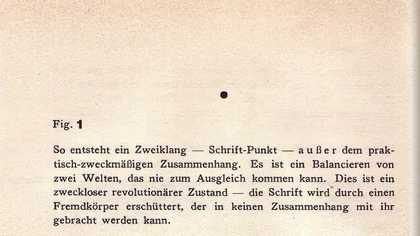
Fig.2
Wassily Kandinsky
Fig. 1 from Punkt und Linie zur Fläche, Albert Langen, Munich 1926
Private collection © DACS, London
Kandinsky thought that his analysis of the graphic qualities of conventional writing contained clues as to how to think the relations between text and image in Sounds. In a letter of 1911 to Michael Sadleir, who published Concerning the Spiritual in Art in 1914, he wrote that there was both an inner and an outer relationship between the texts and the woodcuts: ‘I treat the word, the sentence in a very similar way to that in which I treat the line, the spot.’17 But Sounds is more complex than the passages we have just followed in Kandinsky’s theoretical texts. In Sounds, words in the poems function conventionally and, simultaneously, move toward free graphic form, becoming abstract. At the same time, the images in the album are representational and, simultaneously, move toward free graphic form, becoming abstract. Each of these moments Kandinsky describes as a Doppelklang18 – a neologism to describe an entity that is a double-sound or chord consisting of quite contrary elements. To this already complex process, we must add the third tension in which text as poem and image as vignette distinguish each from the other, and yet continuity between poem and vignette is established as free graphic form. The white paper upon which each of these tensions stands is the ground that now becomes a battleground on which continuity and conflict are acted out. This instability is important to Kandinsky, and is further developed in his writings.
The 1926 passage on point describes the point as a break in writing, a ‘symbol for interruption, for non-being (negative element)’ and as a ‘bridge from one entity to the next (positive element)’. The point functions simultaneously as disjunction and as conjunction. This contradictory formulation is underscored by the assertion that the ‘sound of silence habitually associated with the point is so deafening that it drowns all its other qualities.’19 Describing the moment of transition from the point’s status as punctuation to a purely graphic element, Kandinsky writes at the end of the passage: ‘Thus, a chord is sounded [So entsteht ein Zweiklang] – writing-point – … It is the balancing of two worlds that can never attain equilibrium.’20 It was a ‘purposeless revolutionary state’. Zweiklang (literally, a ‘two-sound’) is a word Kandinsky uses repeatedly, along with Doppelklang and Dreiklang (a ‘three-sound’ or triad), in his writings to describe the unification of separate elements into a whole while maintaining that they remain separate, that they can never attain sustained balance.
Kandinsky sought throughout this oeuvre to unite the most diverse phenomena, seeing opposition and conflict as essential constituents of that unity. Thus, of the laws in nature and art, he wrote in Point and Line to Plane: ‘we now discover again the law of opposition and of juxtaposition. This law gives rise to two principles – the principle of parallelism and the principle of contrast.’21 Laws of opposition and contrast recur through the writings from 1910, and map directly onto the principles of juxtaposition and opposition that, as we have seen, Kandinsky came to formulate for the synthesis of the arts.
Thus, the unity that Kandinsky seeks may be seen as one of disunity. Repeatedly he sought motifs that embodied such unity. A good visual example is found in the painting Dominant Curve, 1936 (fig.3) in which we see, to the right, a form derived from ‘Schröder’s Staircase’, a reversible figure devised before 1870 and widely reproduced in psychology textbooks,22 which can be read in spatially contradictory ways (a plane read as an ascender can also be read as a tread-board, though not quite simultaneously). In this work and others like it – and there are a number in Kandinsky’s oeuvre – two contradictory readings of spatial relations are possible as, within an instant, that which was depth becomes surface and vice versa. One form, two contradictory readings. The same was said of the point as it was momentarily both punctuation and free graphic form.
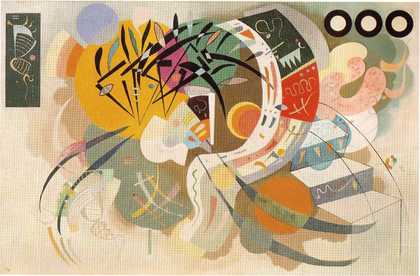
Fig.3
Wassily Kandinsky
Dominant Curve April 1936
Oil on canvas
The Solomon R. Guggenheim Museum, New York © DACS, London
Kandinsky went on to develop an account of this moment of transition or difference between oppositional forces. In the section on point in Point and Line to Plane called ‘At the Boundary’, he introduced a particular type of Doppelklang.23 The text describes how the point approaches and exceeds its outer dimensions; the point begins to disappear and, in embryonic form, the plane begins to live. Kandinsky asks when a point becomes a plane due to the amount of surface it covers, and describes this moment at which the graphic element is both point and plane as a Doppelklang. He asserts that such boundaries are ‘indistinct and mobile’ as the identity of point and, later, line is established in a relation of size to the surface upon which it stands and to other forms on the surface. The identity of each element exists as such only in relation to others and that identity, he writes, is characterised by ‘instability, … flickering tension.’24
The passage moves next to a consideration of a point’s external boundary, and describes ‘different shaped points’.25 Fig.3 of the volume (fig.4) offers a series of twelve of these. One is round; most have clearly circumscribed edges; some have quite erratic, ‘open’ edges which allow the ground to appear within the outer extremities of the point. In the latter – particularly in the case of the ‘point’ composed of vertical and horizontal lines – the relation of the figure to its ground is less clear. Fig.4 (fig.5) offers a perfectly round point at the centre of Kandinsky’s Urbild. Fig.5 (fig.6) offers an image of that point exploding, dissipating across the picture plane in a series of tiny points. These threaten to classify the relatively enormous central point as a plane, and at the boundary of the point (actually, the centre of a nebula in Hercules, according to the caption) the edge is effectively dissolved. Thus, the distinction ‘figure/ ground’ is all but lost as the identity of the central point is twice undermined – as a point that becomes a plane because of its size, and by its diffuse edge which the ground invades. Here the dual (and contradictory) identity of the point illustrates the concept of the Doppelklang.
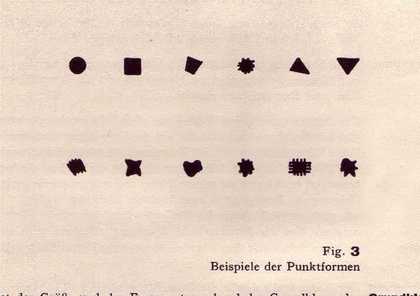
Fig.4
Wassily Kandinsky
Fig. 3 from Punkt und Linie zur Fläche, Albert Langen, Munich 1926
Private collection © DACS, London
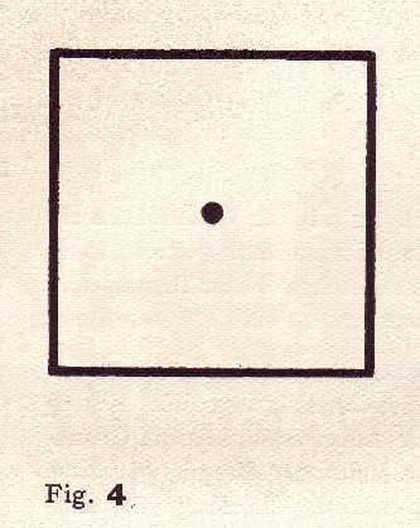
Fig.5
Wassily Kandinsky
Fig.4 from Punkt und Linie zur Fläche, Albert Langen, Munich 1926
Private collection © DACS, London
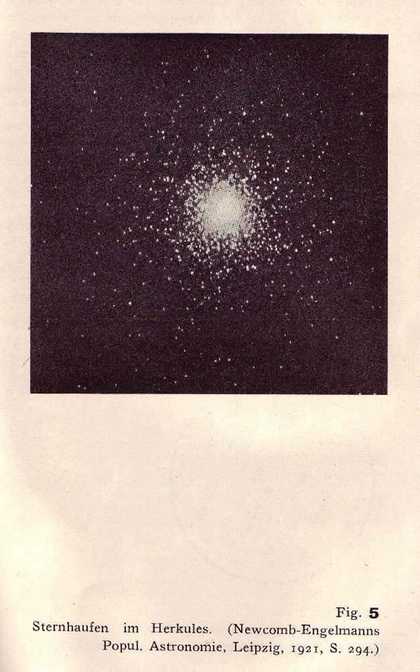
Fig.6
Wassily Kandinsky
Fig.5 from Punkt und Linie zur Fläche, Albert Langen, Munich 1926
Private collection © DACS, London
The boundary is a fundamentally important motif for Kandinsky. It is that which divides one thing from another, whether a point from its ground, one art from another, or a nation from its neighbour. It is a site simultaneously of differentiation and of unification. In this, the graphic boundary has the same function as the full-stop as accounted for in Point and Line to Plane: the stop is a ‘symbol for interruption, for non-being’ and simultaneously a ‘bridge from one entity to the next.’ Like the point in a sentence thus characterised, the graphic boundary is that which simultaneously separates and unites.
Conclusion
The album Sounds contains three elements of tension that occur across boundaries: words that function both conventionally and as free graphic form; images that function representationally and as free graphic form; and a combination of words and image, each of which functions according to different conventions. The first two operate simultaneously; the third stands as more of a commentary on the first two, and operates more gradually. Nonetheless, ‘instability [and] flickering tension’ across unstable boundaries, as Kandinsky describes it, operates through the pages of Sounds. This condition relates to Kandinsky’s hopes for synthesis within the arts in general. Each art is to establish that which is particular to itself yet, at the same time, is to find that which connects it to other arts. Thus, the album can be seen as a model for thinking the integration of the arts. More generally, the album can also be seen as reflecting Kandinsky’s rejection of the ‘either-or’ formulation that he saw as characterising the nineteenth century, and his aspiration to replace it with the ‘and’ that he hoped would characterise the twentieth. This would not entail the destruction of boundaries but rather a reconceptualisation of boundaries. In the essay ‘And, Some Remarks on Synthetic Art’ (1927) Kandinsky wrote:
The beginning [of the new epoch] consists in the recognition of interrelationships. More and more, people will see that there exist no ‘specialised’ questions, to be identified or solved in isolation, since in the end, everything is interconnected, interdependent. The continuation of this beginning consists in discovering further interrelationships and exploiting them in the service of human development, the most important task of mankind.’26
The parallel and oppositional dynamics found within the album Sounds constitute one moment in the process that leads to the realisation of such ambition.

